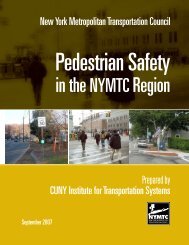Chapter 3 The Transportation System - New York Metropolitan ...
Chapter 3 The Transportation System - New York Metropolitan ...
Chapter 3 The Transportation System - New York Metropolitan ...
- No tags were found...
You also want an ePaper? Increase the reach of your titles
YUMPU automatically turns print PDFs into web optimized ePapers that Google loves.
<strong>Chapter</strong> 3available to the <strong>New</strong> <strong>York</strong> City subwaysystem at the World Trade Center, 14 thStreet, 23 rd Street, and 33 rd Street. <strong>The</strong>PATH system also serves <strong>New</strong>ark PennStation, a major transportation hub indowntown <strong>New</strong>ark. (See Table 3.2 forannual ridership.)<strong>New</strong> fare media and new railcars figuredprominently in PATH’s developmentsince 2008. Although PATH acceptednon-NYCT-compatible MetroCardswhen it introduced its contactless SmartLinkcard in 2007, within 2 years halfof all PATH customers had switchedto SmartLink. In 2010, PATH tested across-jurisdictional, contactless farecardwhich could be used on three connectingNJTransit bus routes, eight MTA NYCTbus routes, and the Lexington Avenue(4,5,6) Line.PATH’s rolling stock has recently beenentirely replaced by 340 new PA5 cars,with the first train of new cars enteringservice in July 2009, and the entirefleet of older cars – some of which datedback to the mid-1960s – being replacedby October 2011. Less visible but ofequal significance was the October 2009awarding of $340 million in contractsto replace PATH’s entire signal networkwith an electronically-managed automatictrain control system.Construction continued on the WorldTrade Center <strong>Transportation</strong> Hub whichincludes a new entrance to the temporaryPATH terminal that opened inMarch 2008. <strong>The</strong> hub’s last major contractwas awarded in February 2011 andthe hub station is expected to open inearly 2015. 6COMMUTER RAIL<strong>The</strong> region has three commuter rail entities– the MTA Long Island Rail Road(LIRR), MTA Metro-North Railroad(Metro-North), and <strong>New</strong> Jersey Transit(NJ Transit). <strong>The</strong> LIRR and Metro-North are subsidiaries of <strong>New</strong> <strong>York</strong>State’s MTA. Compared to subwayservice, commuter rail services generallyoffer greater distances between stations,wider coverage areas, zoned fares,and a greater emphasis on rider comfort.<strong>The</strong>re are also regulatory differences asall three agencies fall under Federal RailroadAdministration jurisdiction becausetheir tracks are connected to the nationalrailroad network. Generally, commuterrail operations are separated from rapidtransit, which is regulated by the FederalTransit Administration. 7From April 2012 to March 2013, theLIRR carried a rolling 12-month averageof approximately 6.8 million passengertrips per month on 735 daily trains.<strong>The</strong> LIRR system is comprised of over700 miles of track situated on 11 differentbranches, stretching 120 miles fromMontauk – on the eastern tip of LongIsland – to Penn Station in the heart ofManhattan, and to Atlantic Terminal inBrooklyn.Metro-North recently surpassed theLIRR as the busiest commuter railroadin North America, servicing 120 stationsdistributed across five lines in sevencounties in <strong>New</strong> <strong>York</strong> State – Dutchess,Putnam, Westchester, Bronx, Manhattan,Rockland, and Orange, as well astwo counties in the state of Connecticut– <strong>New</strong> Haven and Fairfield. From April2012 to March 2013, Metro-North carrieda rolling 12-month average of approximately6.9 million passenger tripsper month on 697 daily trains.Although <strong>New</strong> Jersey Transit’s rail operationsare primarily outside the NYMTCregion, most of its rail routes indirectlyor directly serve <strong>New</strong> <strong>York</strong>’s Penn Station.From April 2012 to March 2013,NJT’s rail operations carried a rolling12-month average of approximately 6.0million passenger trips, nearly equalingthe LIRR’s and Metro-North’s ridershiplevels. (<strong>The</strong> impacts of Hurricane Sandy,along with more severe winter weather,reduced this average by approximately200,000 from 6 months earlier.)NJ Transit is <strong>New</strong> Jersey’s public transportationcorporation which serves anarea of 5,325 square miles and operates acommuter rail network (along with fleetsof buses and light rail vehicles) – includingfive rail lines that link directly into<strong>New</strong> <strong>York</strong> Penn Station in Manhattan.Railroad ridership generally continuedto climb to levels not seen in recent history.In, 2008, its 25 th anniversary year,Metro-North set a ridership record,while the LIRR attracted over 87 millionpassengers. However, system-wideusage declined in 2009 before stabilizingin 2010.By April 2013, <strong>The</strong> LIRR East Side Accessproject, a plan to construct a LIRRterminal beneath Grand Central Terminal,had completed all blasting in thetunnels and caverns, and the project hadspent 52.4 percent of its $245 billionbudget. <strong>The</strong> MTA estimated that theproject would be completed in August2019.In September 2009, Metro-North <strong>New</strong>Haven Line trains began through serviceto the Meadowlands for football gamesand special events. In May 2009, Metro-Northalso opened a new train stationon the Hudson Line, located near YankeeStadium. By the 2012 baseball season,game-day ridership averaged nearly3,100 on weekdays and 4,100 on weekends.11In January 2009 the LIRR and Metro-North entered into a $257 million jointprocurement contract with multipleparts suppliers – the largest mutual effortbetween the two railroads yet.Transit-oriented development (TOD)also began to play a more visible rolein the relationship between commuterrail and land use, as the MTA and itsNYMTC partners sought to encouragemore use of walkable communities nearsome of its stations, such as Harrison,<strong>The</strong> <strong>Transportation</strong> <strong>System</strong> 3-9
















